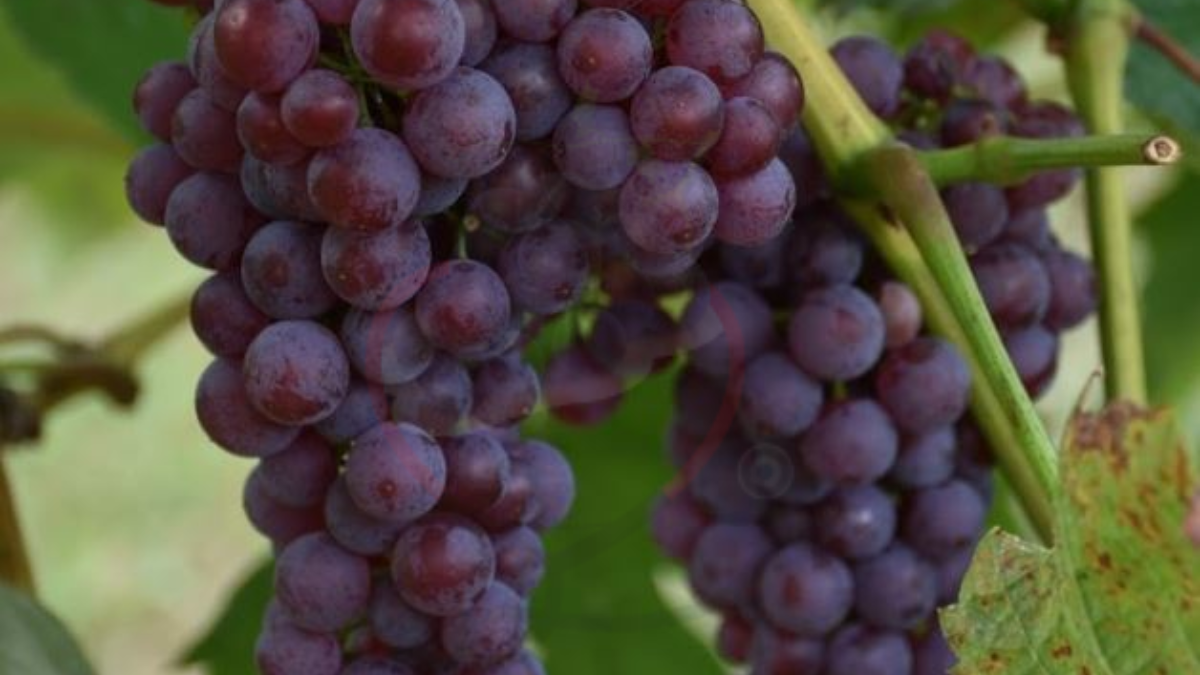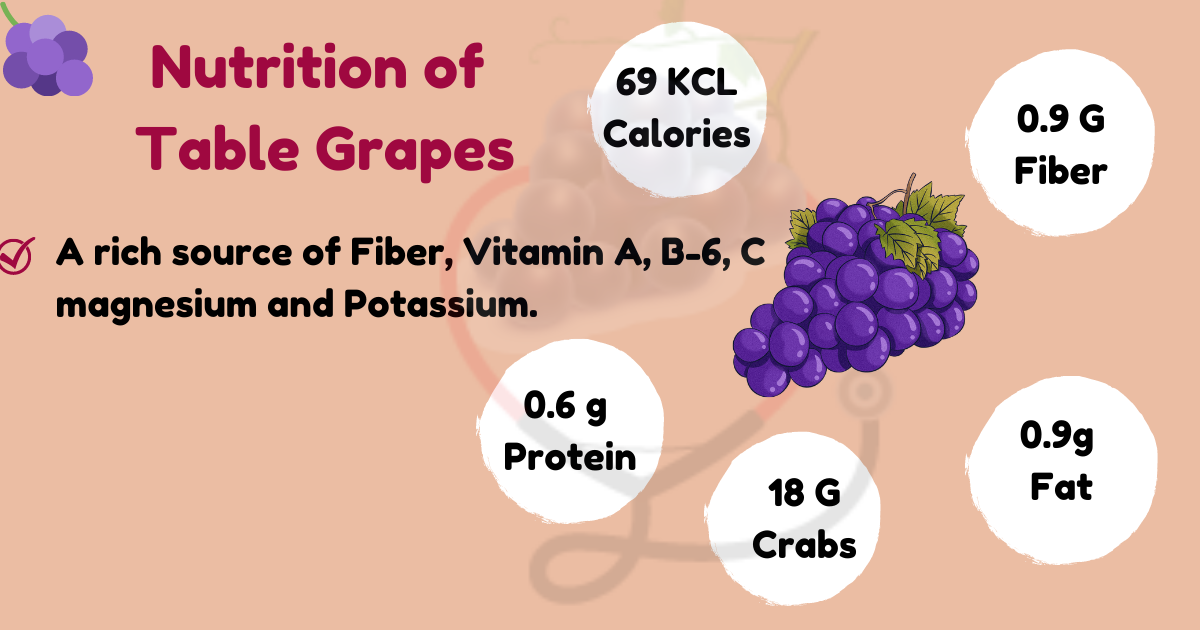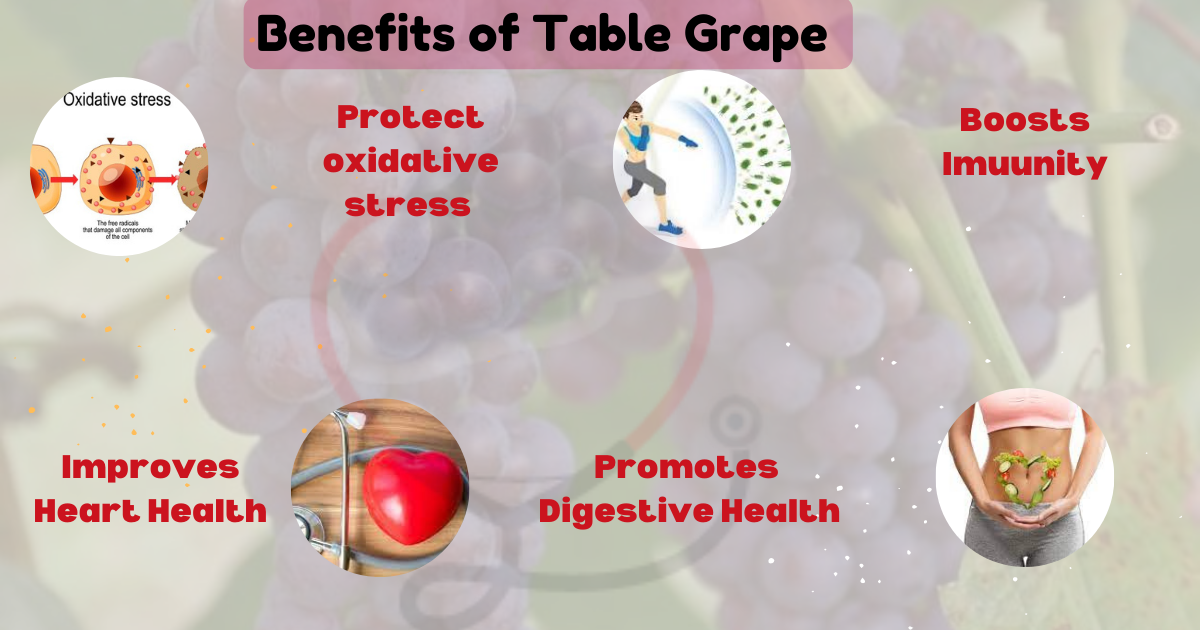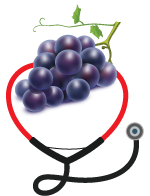Table grapes are a delightful and nutritious fruit that are enjoyed around the world.
Table grapes, scientifically known as Vitis vinifera, are grapes that are primarily grown for eating fresh. [1]
Table grapes are known for their sweet and juicy taste, making them a popular snack or ingredient in various culinary creations.
Unlike grapes grown for winemaking or raisins, table grapes are specifically cultivated for fresh consumption.
With a wide variety of flavors, colors, and textures, table grapes offer a versatile and delicious addition to any diet.
They come in a wide range of colors, including red, green, and black, each offering its unique flavor profile.
In this article, we will explore the different varieties of table grapes, their health benefits, tips for growing and harvesting them.

Origin of Table Grapes
Table grapes originated in the Middle East around 6000-8000 years ago.
Cultivated by ancient civilizations like the Mesopotamians and Egyptians, they spread through trade to Europe and the Americas.
Today, they’re enjoyed worldwide as a sweet and juicy fruit.
Growing and Harvesting Table Grapes
Table grapes are typically grown in temperate regions with suitable climate conditions.
Here are some key points to consider when growing and harvesting them.
1: Climate and Soil
Table grapes thrive in areas with warm, dry summers and mild winters.
They prefer well-draining soil with good fertility.
2: Planting and Pruning
Grapes are usually propagated from cuttings or grafted onto rootstocks.
Proper pruning techniques are essential for maintaining healthy vines and maximizing fruit production.
3: Harvesting
Grapes should be harvested when they reach optimal ripeness, which is determined by their color, texture, and taste.
They should be handled carefully to avoid damaging the delicate clusters.
Nutritional Values of Table Grapes
The nutritional values of table grapes per 100 grams are approximately as follows. [2]

- Calories: 69 kcal
- Carbohydrates: 18 grams
- Sugars: 16 grams
- Fiber: 0.9 grams
- Protein: 0.6 grams
- Fat: 0.2 grams
- Vitamin C: 3% of the Daily Value (DV)
- Vitamin K: 14% of the DV
- Vitamin B6: 6% of the DV
- Potassium: 191 mg (4% of the DV)
- Magnesium: 7 mg (2% of the DV)
Popular Varieties of Table Grapes

1: Thompson Seedless
This green grape variety is one of the most popular table grapes. [3]
It is seedless, sweet, and has a crisp texture.
2: Red Globe
Red Globe grapes are large, round, and have a deep red color. [4]
They are known for their sweet and slightly tangy flavor.
3: Crimson Seedless
Crimson Seedless grapes are medium-sized and have a beautiful crimson color.
They are juicy, sweet, and perfect for snacking. [5]
4: Black Muscat
Black Muscat [6] grapes are small and have a dark purple or black color.
They are prized for their intense sweetness and aromatic flavor.
5: Princess Seedless
Princess Seedless grapes [7] are green, seedless, and have a slightly tart taste.
They are often used in salads or as a refreshing snack.
Health Benefits of Table Grapes
Table grapes offer a range of health benefits due to their rich nutritional profile. Here are some key benefits.

1: Antioxidant-Rich
Grapes are packed with antioxidants, such as resveratrol and flavonoids, [8] which help protect the body against oxidative stress and inflammation.
2: Heart Health
The natural compounds in table grapes, including polyphenols and fiber, [9] promote heart health by reducing the risk of cardiovascular diseases.

3: Digestive Health
Grapes contain dietary fiber, [10] which supports healthy digestion and prevents constipation.

4: Immune Boosting
The high vitamin C [11] content in table grapes helps strengthen the immune system and promotes overall well-being.

5: Hydration and Detoxification
With their high water content, table grapes are a hydrating fruit that aids in detoxification and promotes healthy skin. [12]
Delicious Recipes with Table Grapes

1: Grape and Cheese Salad
Combine halved table grapes with a variety of cheeses, such as goat cheese or feta, and toss with mixed greens and a simple vinaigrette.
2: Grape Salsa
Create a unique salsa by combining diced table grapes, red onion, jalapeno peppers, lime juice, cilantro, and a touch of honey.
Serve with tortilla chips or as a topping for grilled chicken or fish.
3: Roasted Grape Crostini
Roast halved table grapes with a drizzle of olive oil and a sprinkle of salt and pepper.
Spread goat cheese on toasted baguette slices and top with the roasted grapes for a flavorful appetizer.
Table grapes are a delicious and healthy fruit that offers a variety of flavors and nutritional benefits.
From their diverse colors and tastes to their potential health-promoting properties, table grapes are a versatile addition to any diet.
Whether enjoyed fresh, added to recipes, or frozen for later use, these grapes provide a burst of natural sweetness and a touch of elegance to your meals.
So go ahead, indulge in the delightful world of table grapes and savor their juicy goodness.
Frequently Asked Questions (FAQs)
Can I eat grape seeds?
While grape seeds are safe to eat, some people prefer to spit them out due to their slightly bitter taste.
Are table grapes genetically modified?
No, table grapes are not genetically modified. They are naturally bred for their desirable traits.
Can table grapes be grown in containers?
Yes, table grapes can be grown in containers as long as they have adequate space, sunlight, and proper support.
What is the best way to remove grape stains?
Rinse the stained fabric with cold water as soon as possible, then pre-treat it with a stain remover before laundering.
Can dogs eat table grapes?
No, grapes and raisins can be toxic to dogs and should be kept out of their reach.

